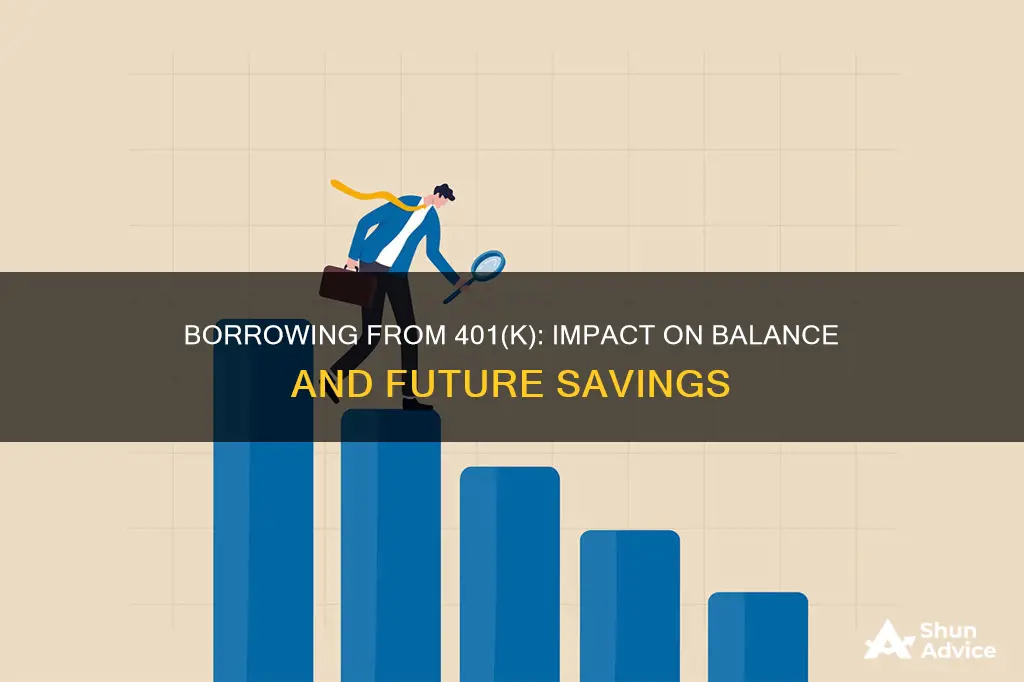
Taking out a loan from your 401(k) plan can be a convenient way to access cash, but it also has its drawbacks. When you take out a 401(k) loan, you are borrowing from your retirement savings account, and the loan must be repaid with interest. While a 401(k) loan can provide short-term liquidity, it may also decrease your overall balance and impact your long-term financial goals. In this paragraph, we will explore the effects of taking a 401(k) loan on your account balance and consider the pros and cons of this decision.
| Characteristics | Values |
|---|---|
| Maximum loan amount | $50,000 or 50% of the vested account balance, whichever is less |
| An exception to the limit | If 50% of the vested account balance is less than $10,000, the participant may borrow up to $10,000 |
| Repayment schedule | 5 years, but can be repaid faster with no prepayment penalty |
| Repayment method | Payroll deductions using after-tax dollars |
| Interest | Paid by the borrower, but it goes back into the borrower's retirement account |
| Credit score impact | No impact on credit score in case of missed payments or default |
| Job loss | The loan has to be repaid in full; otherwise, it is considered an early withdrawal and is subject to taxation and penalties |
| Tax consequences | The unpaid loan balance is included in the participant's taxable income; a 10% penalty may apply if the participant is under 59 1/2 years old |
| Contributions | Some plans prohibit contributions until the loan is repaid; the borrower may miss out on employer-matched contributions |
What You'll Learn

Borrowing from a 401(k) plan
However, there are some serious downsides to borrowing from your 401(k) plan. Firstly, you are depleting the money you are saving and investing for your future. You will also lose out on investing the money you borrow in a tax-advantaged account, missing out on potential growth that could amount to more than the interest you repay. You may also have to repay the loan in full if you leave your job, and if you don't, the unpaid loan balance will be considered a taxable distribution, with a 10% federal tax penalty if you are under 59 and a half. Some 401(k) plans also prohibit contributions to your account until you repay the loan balance, meaning you will miss out on any employer-matching contributions.
If you do choose to borrow from your 401(k) plan, you can usually borrow up to a maximum of $50,000 or 50% of your vested account balance, whichever is less. An exception to this limit is if 50% of the vested account balance is less than $10,000, in which case you may borrow up to $10,000. You will need to pay this money back, plus interest, within five years in most cases, although you can repay the loan faster with no prepayment penalty.
Before taking a loan from your 401(k), consider speaking to an investment advice fiduciary, who is required to act in your best interests.
Sofi Loans: Prepayment Penalties and Their Implications
You may want to see also

Pros and cons of a 401(k) loan
Borrowing from your 401(k) can be a valuable liquidity option, especially compared to an early withdrawal. However, it is not without its drawbacks. Here are some pros and cons of a 401(k) loan to consider:
Pros
- Avoid taxes and penalties: Unlike 401(k) withdrawals, you don't have to pay taxes and penalties when taking a 401(k) loan.
- Interest goes back into your retirement account: The interest you pay on the loan will go back into your retirement account, although on a post-tax basis.
- No credit checks: A 401(k) loan does not require a credit check and will not be listed as debt on your credit report. If you default on the loan, it won't impact your credit score as defaulted loans are not reported to credit bureaus.
- Convenience and lower costs: For short-term liquidity needs, a 401(k) loan can be a simple, convenient, and low-cost source of cash. There is no cost other than a modest loan origination or administration fee.
Cons
- Repayment schedule: You will need to pay back the loan, just like any other loan, with a fixed repayment schedule. If you leave your job, you may have to repay the loan in full within a short time frame.
- Tax and penalty risks: If you default on the loan, you may owe taxes and a 10% penalty on the outstanding balance if you are under 59 1/2 years old.
- Loss of investment growth: You will lose out on investing the borrowed money in a tax-advantaged account, potentially missing out on growth that could exceed the interest you repay.
- Limited access to funds: You might not be able to access as much cash as you need. The maximum loan amount is $50,000 or 50% of your vested account balance, whichever is less.
- Impact on contributions: Some 401(k) plans prohibit contributions to your account until you repay the loan balance. You may also need to reduce or pause your contributions while paying off the loan, affecting your retirement strategy.
- Risk of job loss: If you lose your job before repaying the loan, the remaining balance is due. If left unpaid, it will be considered a taxable distribution with potential tax consequences and penalties.
SBI Loan Closure: Early Exit Fees and Charges?
You may want to see also

Loan repayment
Most plans allow loan repayments to be made through payroll deductions, using after-tax dollars. Your plan statements will show credits to your loan account and your remaining principal balance, just like a regular bank loan statement.
It is important to keep up with your regular contributions while repaying your loan to keep your retirement strategy on track. Regulations require 401(k) plan loans to be repaid on an amortizing basis, meaning with a fixed repayment schedule in regular installments. However, you can repay the plan loan faster with no prepayment penalty.
If you leave your job, you may have to repay your loan in full in a very short time frame. If you are unable to repay the loan for any reason, it is considered defaulted, and you will owe both taxes and a 10% penalty on the outstanding balance if you are under 59 1/2.
If you are in the armed forces, your employer may suspend loan repayments during your period of active duty, and then extend the loan repayment period by this period. If, during a leave of absence from your employer, your salary is reduced so that it is insufficient to repay the loan, your employer may suspend repayment for up to a year.
Schwab's Share Lending: What You Need to Know
You may want to see also

Tax consequences
Borrowing from your 401(k) plan can have several tax consequences, both positive and negative. Firstly, a 401(k) loan allows you to avoid paying the taxes and penalties that come with an early withdrawal. Additionally, the interest you pay on the loan goes back into your retirement account, although on a post-tax basis. This means you are paying taxes on the interest twice—when you receive the interest as income, and when you pay it back into your retirement account.
However, if you default on your loan, you will face negative tax consequences. If you leave your job, you will likely have to repay your loan in full within a short time frame. If you can't repay the loan for any reason, it is considered defaulted, and you will owe taxes and a 10% penalty on the outstanding balance if you are under 59 1/2 years old. This is because the unpaid loan balance is treated as a taxable distribution.
To avoid these negative tax consequences, it is advisable to tap into other sources to repay your 401(k) loan before taking a distribution. If you repay the loan and then take a distribution, the full plan balance can qualify for a tax-advantaged transfer or rollover, and the 10% penalty will not apply.
It is important to note that specific tax withholding rules vary depending on the plan and the state, so be sure to review your plan's rules and consult a financial professional or tax advisor before taking out a 401(k) loan.
Synchrony Bank: Understanding Their Loan Offerings and Options
You may want to see also

Interest and gains
When you take a 401(k) loan, you are essentially borrowing from yourself, and you will need to pay back the loan with interest. The interest you pay on the loan will go back into your retirement account, although on a post-tax basis. This means that you are still making gains, but you are repurchasing with interest back into the fund. Depending on the market, you may or may not have more "shares" rebought.
The interest cost of borrowing similar amounts via a bank or other consumer loans (such as credit card balances) may be higher than the interest rate of a 401(k) loan. Therefore, a 401(k) loan can be a valuable liquidity option, especially if you require short-term funds for the right reasons.
However, it is important to note that you may lose out on potential growth in your retirement account by taking out a 401(k) loan. The money you borrow will no longer be invested and earning returns in a tax-advantaged account. This potential growth could amount to more than the interest you repay on the loan. Additionally, some 401(k) plans prohibit contributions to your account until you repay the loan balance, causing you to miss out on employer-matched contributions.
If you leave your job, you may have to repay your loan in full within a short time frame. If you are unable to repay the loan, it is considered defaulted, and you will owe taxes and a potential 10% penalty on the outstanding balance if you are under 59 1/2 years old.
SAP and Unsubsidized Loans: What's the Connection?
You may want to see also
Frequently asked questions
A 401k loan is when you borrow money from your retirement savings account. You can borrow up to \$50,000 or 50% of your vested account balance, whichever is less. You will have to pay back the borrowed money, plus interest, within five years.
Yes, taking a 401k loan decreases your account balance. The interest you pay on the loan goes back into your retirement account, but you lose out on potential growth that could amount to more than the interest you repay.
Taking a 401k loan can be a simple, convenient, and low-cost way to access cash. It can help you avoid paying taxes and penalties on early withdrawals from your retirement account. Additionally, a 401k loan does not require a credit check and will not impact your credit score if you default.
If you leave your job, you may have to repay your 401k loan in full within a short time frame. Defaulting on the loan can result in taxes and penalties, and you may miss out on the benefits of investing the borrowed money in a tax-advantaged account.







